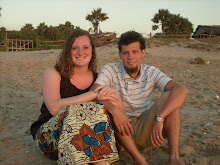Most transports have 2 large back doors, like a delivery van, for entering and exiting. Some also have a sliding side door, or a door that used to slide and now opens by hinges. Then they always have your two front doors that all vehicles have. Some that only have 2 back doors for main entering and exiting make it fairly difficult to get in and out of considering the vans are usually quite full. This also makes riding long distances fairly uncomfortable and smelly since it is a hot climate, with many people, in a small space that is all metal making it feel a bit like a toaster oven.
The benefit to public transport here compared to many other countries though is that there is a limit to how many passengers the van can legally carry. All passengers have to be seated, there may be "too many" on a seat by our standards, but the more that can fit, the more money the driver and his apprentice make. In many other countries, you are fortunate to get a seat and then there is always more room for standing passengers (this was my experience in Bolivia and I have heard stories of it being the same way in other countries). To enforce this law there are various police check points set up along the roads that look into the vans to make sure that it is not overcrowded. It has not always been this way, but not too many years ago this became a law and has been enforced since.
Now onto our most recent transport adventure. Last evening we were coming home from Pirang and right as we reached the road, what looked to be a transport was coming along. We flagged the van down and hopped in. This van was different however. The seats looked like mini tour-bus seats and there was even a baggage rack above our heads. Elias and I looked at each other and questioned whether we were actually in a public transport or if we had just flagged down a group traveling into kombo, the city area, from up country. People will flag down any vehicle passing here and many times pickup trucks, cars and SUV's will pick up people on the side of road as they pass. As we continued on I noticed more and more the bright red dust that is only found farther up country where the main road is no longer paved. I first noticed the dust on the floor. It was so thick that I couldn't actually see the floor itself. Then I noticed it on the seats, on people's clothing and then I even notice it in their hair and skin. This is the same dust that caused Elias and I to come home early from the youth camp we went to in December as it was too much for Elias' lungs. It covers everything and as dry season progresses it becomes worse. Soon however, the rainy season will be here making travel more difficult and muddy instead of dusty. I'm not sure where the transport was coming from, but it must have been a decent distance as people were coming in with duffle bags for their stay.




The old lady just found out how to connect with your blog. What a travel adventure, esp at The Traffic Light. Good job at problem-solving!!! As Lori said in her blog: prayer does make a difference! D and G
ReplyDelete